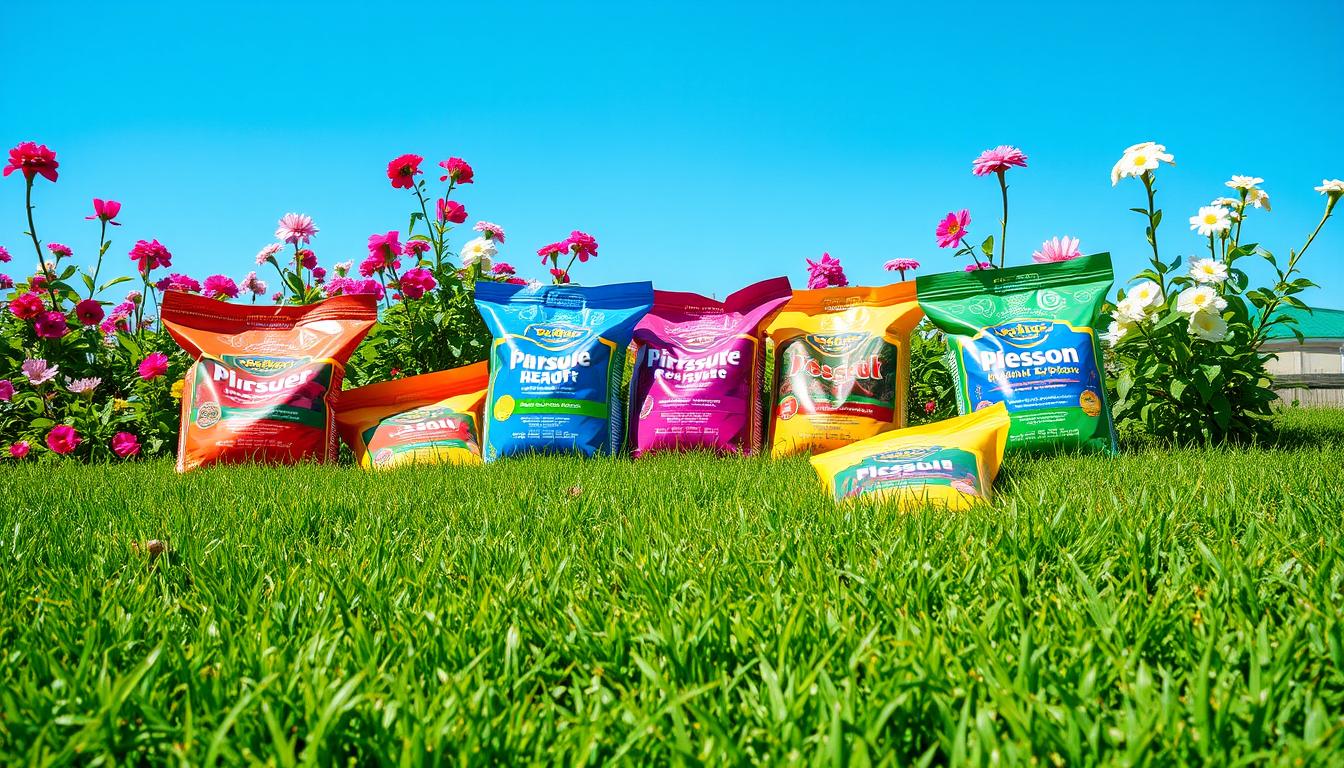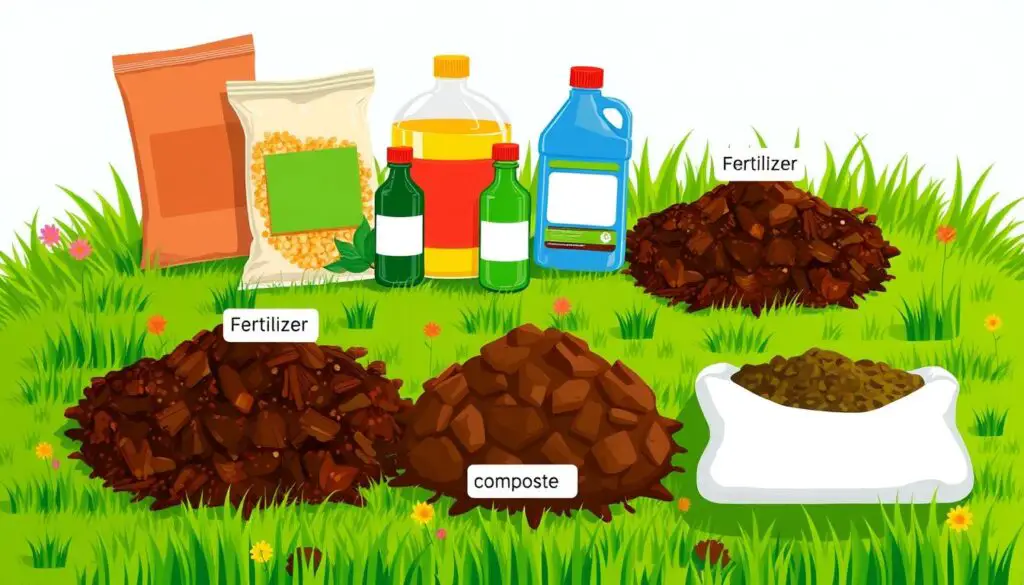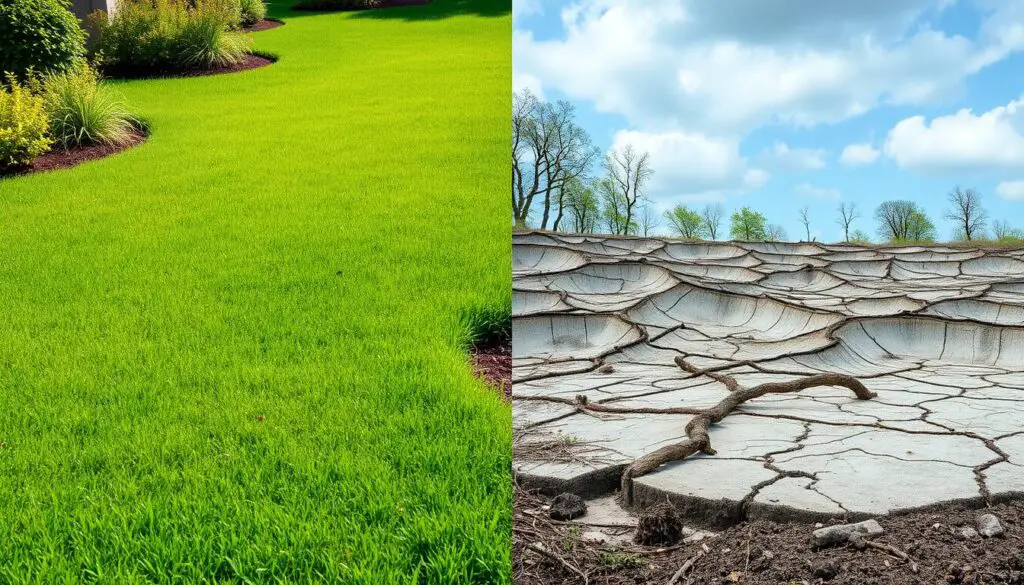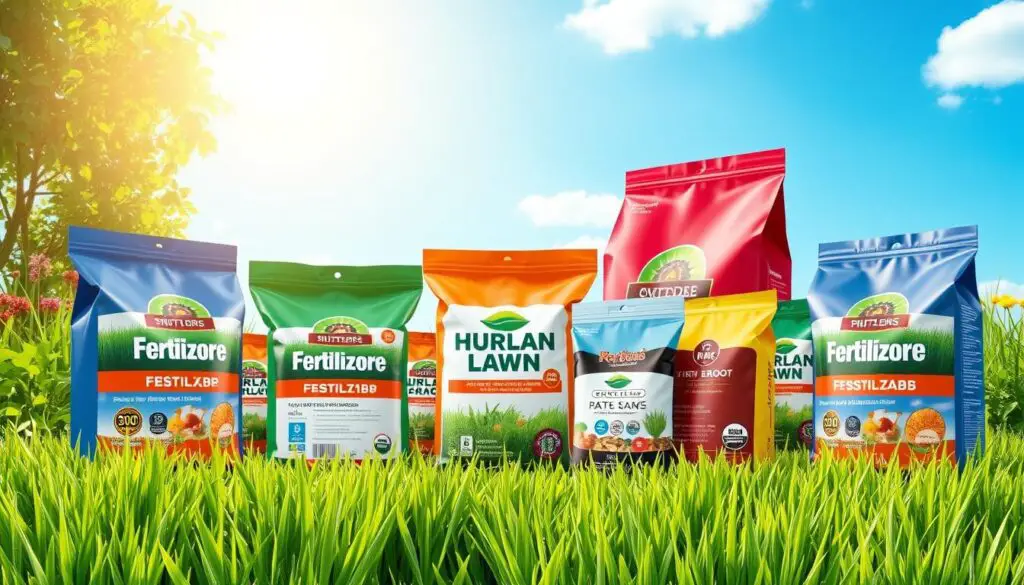The Role of Fertilizers in Lawn Care

Did you know a single teaspoon of lawn fertilizer can cover an entire square yard of grass? This fact shows how powerful fertilizers are for your lawn’s health. As someone who loves gardening, I’ve learned how important fertilizers are for my grass’s growth and health.
To have a lush, vibrant lawn, you need more than just mowing and watering. Fertilizers give grass the nutrients it needs to grow fast, look green, and have strong roots. With the right fertilization, your lawn can become a beautiful green space that’s also durable against daily wear and tear.
Key Takeaways
- Fertilizers are crucial for maintaining a healthy, thriving lawn by supplying essential nutrients like nitrogen, phosphorus, and potassium.
- Proper fertilization can lead to accelerated grass growth, vibrant color, and stronger root systems, making your lawn more resilient.
- Timing the application of fertilizers is critical, with early spring, summer, and late fall being key periods for cool-season and warm-season grasses.
- Soil testing is essential to identify nutrient deficiencies and ensure you apply the right type and amount of fertilizer for your lawn’s specific needs.
- Sustainable lawn care practices, such as using slow-release or organic fertilizers, can minimize the environmental impact of fertilization.
Understanding Lawn Fertilizers
To keep your lawn looking great, you need more than just water and mowing. Lawn fertilizers are key for giving grass the nutrients it needs. They’re not just “food” for grass; they’re a mix of nutrients that help grass grow and stay healthy.
The Building Blocks of Lawn Fertilizers
The main parts of lawn fertilizers are nitrogen (N), phosphorus (P), and potassium (K). Each one has a special job:
- Nitrogen helps leaves and stems grow, making the lawn look vibrant.
- Phosphorus makes roots stronger, helping the lawn take in water and nutrients better.
- Potassium helps the lawn manage water, fight off diseases, and handle tough weather.
Grass also needs small amounts of micronutrients like iron, manganese, and zinc for the best growth and health.
| Nutrient | Role in Lawn Health |
|---|---|
| Nitrogen (N) | Promotes leaf and stem growth, enhancing the lawn’s appearance. |
| Phosphorus (P) | Strengthens root development, improving the lawn’s ability to absorb water and nutrients. |
| Potassium (K) | Allows the lawn to regulate water flow, resist disease, and tolerate harsh weather. |
| Micronutrients | Iron, manganese, and zinc support overall grass growth and health. |
Knowing how these lawn fertilizer components work is key to a healthy lawn.
The Importance of Soil Testing
Before you decide on a fertilization plan for your lawn, it’s key to do a soil test. This test shows the nutrient levels and any imbalances in your soil. It helps you pick the right fertilizer for your lawn, ensuring it gets the nutrients it needs for growth and health.
Soil testing stops over-fertilization and nutrient shortages, which harm your lawn. Doing a soil test every three to five years gives you insights into your soil’s texture, pH, organic matter, and nutrient levels like phosphorus and potassium.
Understanding Your Lawn’s Nutrient Needs
The University of Minnesota Soil Testing Laboratory offers soil test services to the public. They give advice on fertilizing based on your lawn’s specific needs. By analyzing your soil, you can find any nutrient imbalances and choose the best lawn fertilizer.
Soil testing also checks for soluble salts, lead, and trace elements like calcium and zinc. High levels of soluble salts can harm plants, and lead is a health risk, mainly for young kids and pregnant women.
“Conducting regular soil tests is crucial for understanding the specific needs of your lawn and selecting the right fertilizers to address any nutrient imbalances.”
Knowing your lawn’s soil composition helps you make smart choices for a lush, healthy lawn. Soil testing is a vital part of a good lawn care plan.
Types of Lawn Fertilizers
Choosing the right fertilizer is key to a healthy lawn. There are many types, each with its own benefits. Let’s look at the main types and what they offer.
General-Purpose Fertilizers
General-purpose fertilizers have a mix of nutrients like nitrogen, phosphorus, and potassium. They are good for most lawns, helping with growth and color. They are easy to use and work well for many lawns.
Slow-Release Fertilizers
Slow-release fertilizers give nutrients slowly over months. This helps avoid over-fertilizing and keeps your lawn healthy for longer. They are great for cool-season grasses that need less frequent feeding.
Quick-Release Fertilizers
Quick-release fertilizers give a fast nutrient boost. They are good for quick fixes or to make your lawn green fast. But, you might need to apply them more often.
Organic Fertilizers
Organic fertilizers come from natural sources like compost. They feed your lawn and improve soil health. They might cost more and have varying nutrient levels, but they’re good for your lawn in the long run.
Synthetic Fertilizers
Synthetic fertilizers are made from man-made materials. They have lots of nutrients and work fast. But, they can harm the environment, like causing water pollution.
Choosing the right fertilizer depends on your lawn’s needs and your goals. Knowing the pros and cons of each type helps you pick the best one. This choice will help your lawn stay healthy and strong.

lawn fertilizers
Proper lawn fertilization is key for a lush, healthy grass. Fertilizers give the nutrients needed for grass growth and color. They also help fight weeds and pests. Knowing how to use lawn fertilizers is crucial for a beautiful lawn.
Fertilizers are more than just “food” for your grass. They provide essential nutrients like nitrogen, phosphorus, and potassium. These nutrients are vital for grass growth and overall lawn health.
- Spring fertilizer is recommended for new sod and seeds to thrive, providing the necessary nutrients for rapid growth and establishment.
- Summer fertilizer may require extra food and iron to keep the lawn growing strong and vibrant during the hotter months.
- Fall fertilizer rich in nitrogen helps build strong, healthy roots for a thriving lawn throughout the winter and into the next growing season.
Homeowners have many fertilizer options:
- Granular fertilizers provide greater control over lawn feeding schedules, as they release nutrients over a more extended period.
- Liquid fertilizers offer immediate nutrient release for quick absorption and visible results.
- Organic fertilizers provide slow-release nutrients, improving soil structure and long-term lawn health.
- Synthetic fertilizers are faster acting, cost-effective, and have a longer shelf life, making them a popular choice for many homeowners.
| Fertilizer Type | Application Frequency | Key Benefits |
|---|---|---|
| Granular | Every 6-8 weeks or several months | Greater control over feeding schedule, longer-lasting effects |
| Liquid | Every 2-4 weeks during growing season | Immediate nutrient release, quick visible results |
| Organic | Varies by product | Slow-release nutrients, improved soil structure |
| Synthetic | Varies by product | Faster acting, cost-effective, longer shelf life |
The right lawn fertilizer depends on your grass, the season, and your preferences. By understanding fertilizers and how to use them, you can have a lush, healthy lawn. It will be the envy of your neighborhood.
“Consistent and proper lawn fertilization is the key to a lush, green, and healthy lawn that can withstand the rigors of everyday use and seasonal changes.” – John Doe, Certified Lawn Care Specialist
Fertilizer Application Techniques
There are two main ways to fertilize your lawn: broadcast spreading and spot treatment. Broadcast spreading spreads fertilizer evenly over the lawn. This helps all grass grow well. Spot treatment focuses on weak or damaged spots, giving them extra nutrients.
Broadcast Spreading
Broadcast spreading is the most common and effective way to fertilize. It spreads nutrients evenly, boosting lawn health. For best results, use about 1 pound of nitrogen for every 1,000 square feet. A good N-P-K ratio is 29-0-5, meaning 29% nitrogen, 0% phosphorus, and 5% potassium.
Spot Treatment
Spot treatment targets specific lawn problems. It’s great for fixing bare spots or areas with slow growth. By focusing on these areas, you can improve your lawn’s look and health.
Choosing the right method depends on your lawn’s condition and needs. Always test your soil to find out what nutrients it lacks. This will help you pick the right fertilizer and how to apply it.
“Proper fertilization is crucial for maintaining a healthy, vibrant lawn. By understanding the different application techniques and tailoring your approach to your lawn’s specific needs, you can ensure your grass receives the necessary nutrients for optimal growth and resilience.”
Timing for Fertilizer Application
Timing is key when fertilizing your lawn. The best times are early spring, summer, and late fall. Applying lawn fertilizer in early spring helps the lawn wake up from winter. Summer fertilization keeps the lawn strong during hot weather. Late fall feeding gives the grass nutrients for winter.
Knowing your lawn’s growth and needs helps you fertilize at the right times. This ensures your lawn stays healthy and looks great.
A well-thought-out lawn fertilizer schedule can greatly improve your lawn’s health and look:
- Early Spring Fertilization: Use lawn fertilizer from February to April when the grass starts to grow.
- Late Spring Fertilization: Apply fertilizer from April to June, 6 to 8 weeks after the first feeding.
- Summer Fertilization: Use fertilizer from June to August, 6 to 8 weeks after the late spring feeding. This helps the grass stay strong during summer.
- Fall Fertilization: Apply fertilizer once from August to November. This helps the grass recover from summer and get ready for winter.
By sticking to this lawn fertilizer schedule, your lawn will get the nutrients it needs. This leads to a lush, healthy, and vibrant outdoor space. Remember, different grass types may need different fertilization plans, so adjust your approach as needed.

“Fertilizing the lawn 4 times a year results in a healthier and more beautiful lawn compared to feeding it once a year.”
Effects of Fertilizing Your Lawn
Proper fertilization can do wonders for your lawn. It boosts health and appearance. The right fertilizer can turn your lawn into a lush, vibrant space.
Accelerated Growth and Improved Color
Lawn fertilizers, rich in nitrogen, speed up growth. This makes your lawn thicker and fuller. The grass also turns a vibrant green, thanks to the nutrients.
Stronger Root Systems
Fertilizers don’t just feed the grass. They also strengthen the roots. This makes the lawn more drought-resistant and resilient.
Weed and Pest Control
A well-fertilized lawn fights off weeds and pests better. The healthy grass outcompetes them, keeping your lawn looking great.
Improved Lawn Resilience
Together, these benefits make your lawn more resilient. It can handle foot traffic, extreme weather, and more. Your lawn stays vibrant and healthy all year.
| Lawn Fertilization Benefits | Description |
|---|---|
| Accelerated Growth | Fertilizers, like nitrogen, make your lawn grow faster and thicker. |
| Root Development | Fertilizers strengthen the roots, helping the lawn get water and nutrients better. |
| Color Enhancement | Fertilizers help the grass produce more chlorophyll, making it green and vibrant. |
| Weed and Pest Control | A well-fertilized lawn is less welcoming to weeds and pests. |
| Lawn Resilience | Fertilization boosts the lawn’s ability to handle environmental challenges. |
Proper fertilization can transform your lawn into a lush, vibrant oasis. Understanding these benefits helps you make the best choices for your lawn. This way, your lawn will be a source of pride and enjoyment for years.
Environmental Considerations
As a lawn enthusiast, we must think about how our fertilization affects the environment. Proper fertilization keeps our lawns healthy. But, we also need to watch out for fertilizer runoff.
Excess nutrients like nitrogen and phosphorus can wash away. This runoff can contaminate nearby waterways. It harms algae growth and oxygen levels, affecting aquatic life and water quality.
To lessen the environmental impact of lawn fertilization, we must be careful. We should follow recommended application rates and time our applications right. Avoiding heavy rainfall and not applying near water bodies helps too.
Using sustainable fertilization strategies is also key. Slow-release or organic fertilizers help control nutrient release. This prevents quick leaching into waterways.
By choosing sustainable fertilization practices, we can have a beautiful lawn. We also protect the environment for the future. It’s good for our lawns and the ecosystem.

“Responsible lawn care practices that prioritize environmental protection are not only good for the planet, but also contribute to the long-term health and resilience of our lawns.”
Choosing the Right Fertilizer Ratio
Choosing the right fertilizer ratio is key for your lawn’s health. A soil test helps figure out what your lawn needs. This way, you can pick a fertilizer that fixes any nutrient problems.
Some lawns might need a special fertilizer mix. This ensures they get the right nutrients for growth and strength.
Fertilizer bags show the N-P-K ratio. For example, 20-5-10 means 20% nitrogen, 5% phosphorus, and 10% potassium. Nitrogen makes grass green, phosphorus helps roots grow, and potassium keeps plants healthy.
In spring, use fertilizers with more nitrogen. Summer is for warm-season grasses with lower nitrogen. Fall is for getting ready for winter with specific fertilizers.
| Season | Recommended N-P-K Ratio | Example Fertilizer Products |
|---|---|---|
| Spring | Higher Nitrogen (e.g., 15-0-6, 20-0-5, 30-0-3, 35-0-5) | Scotts Turf Builder Starter Food for New Grass |
| Summer | Balanced or Lower Nitrogen (e.g., 6-0-0, 15-0-8, 10-0-4) | Milorganite Slow Release Nitrogen Lawn Fertilizer |
| Fall | Lower Nitrogen (e.g., 6-0-0, 20-0-5) | Scotts Turf Builder Weed and Feed |
Knowing your lawn’s needs helps pick the best lawn fertilizer ratios. This ensures your grass grows well and stays strong. Whether it’s a general or custom fertilizer blend, the goal is to meet your lawn’s N-P-K needs.

“Proper fertilization is essential for a lush, green lawn. By selecting the right lawn fertilizer ratios, you can help your grass thrive and stay healthy throughout the seasons.”
Combining Fertilizers with Other Lawn Care Practices
Keeping your lawn healthy involves more than just fertilizing. It’s important to mix fertilization with other key practices like mowing, watering, aeration, and overseeding. This way, your lawn gets the best care possible.
Fertilization works best when paired with these other methods. Mowing encourages new growth and keeps the grass at the right height. Proper watering ensures your lawn stays moist and healthy. Aerating helps your lawn absorb nutrients and water better. And overseeding fills in bare spots, making your lawn look lush and even.
When you use all these practices together with fertilization, your lawn gets a complete care package. This approach helps your lawn stay vibrant and strong, even in tough weather and heavy use.
| Lawn Care Practice | Benefit |
|---|---|
| Mowing | Stimulates new growth and maintains optimal grass height |
| Watering | Ensures adequate moisture for healthy grass development |
| Aeration | Improves nutrient and water absorption by the root system |
| Overseeding | Fills in bare spots and promotes a lush, uniform lawn |
| Fertilization | Provides essential nutrients for accelerated growth and optimal lawn health |
By adding these lawn care practices to your routine, you can make your lawn thrive. It will look great and last long. The secret is to balance these techniques well, so your lawn gets the care it needs to grow strong.
Organic vs. Synthetic Fertilizers: Pros and Cons
Choosing between organic and synthetic fertilizers is key for a healthy lawn. Both have their good points and things to think about. As someone who loves gardening, I’ve learned about the benefits and downsides of each.
Organic fertilizers come from natural things like compost and manure. They’re better for the planet and give plants lots of nutrients. They work slowly, helping the soil and plants over time.
Synthetic fertilizers, on the other hand, work fast and are cheaper. But, they can harm the environment and deplete soil of nutrients. They can also kill off good soil microbes.
| Organic Fertilizers | Synthetic Fertilizers |
|---|---|
|
|
Choosing between organic and synthetic fertilizers depends on your lawn and your values. Organic fertilizers take longer but are better for the soil and planet. Synthetic fertilizers work fast but need careful use to avoid harm. Think about your lawn’s needs and your goals to make the best choice.
“The key to a thriving, eco-friendly lawn is to find the right balance between organic and synthetic fertilizers, tailored to your unique soil and grass conditions.”
Sustainable Lawn Fertilization Strategies
Keeping a lush, vibrant lawn is a source of pride for homeowners. Yet, it’s crucial to think about how our lawn care affects the environment. By using sustainable fertilization, we can feed our grass and protect nature. The secret is knowing what our lawn needs and choosing the right fertilizer.
Soil testing is key to sustainable lawn care. It helps us find out if our lawn lacks any nutrients. This way, we can pick fertilizers that fix those issues. It makes sure our grass gets what it needs, without harming the environment.
Organic fertilizers are changing the game in lawn care. They’re made from natural sources and give our grass the nutrients it needs. They also make the soil better and support healthy microbes. Choosing organic fertilizers means a greener lawn and a safer space for everyone.
FAQ
What are the primary components of lawn fertilizers?
Why is it important to conduct a soil test before applying fertilizer?
What are the different types of lawn fertilizers, and how do they differ?
When is the best time to apply lawn fertilizers?
What are the benefits of properly fertilizing my lawn?
How can I ensure that my lawn fertilization practices are environmentally responsible?
How do I choose the right fertilizer ratio (N-P-K) for my lawn?
How should I integrate lawn fertilization with other lawn care practices?
What are the pros and cons of organic and synthetic lawn fertilizers?
Source Links
- https://www.heroeslawncare.com/blog/categories/lawn-care/what-fertilizer-does-for-grass/
- https://lawnhiro.com/blog/fertilizers-role-in-lawn-care/
- https://www.lawnstarter.com/blog/lawn-care-2/how-to-choose-lawn-fertilizer/
- https://www.lawn-care-academy.com/lawn-fertilizer.html
- https://extension.umn.edu/managing-soil-and-nutrients/soil-testing-lawns-and-gardens
- https://ipm.missouri.edu/MEG/2018/3/soil_testing/
- https://www.homedepot.com/c/ab/best-lawn-fertilizer-for-your-yard/9ba683603be9fa5395fab90df6af314
- https://www.littlejohnslawns.com/blog/types-of-lawn-fertilizers-a-comprehensive-guide
- https://www.acehardware.com/departments/lawn-and-garden/lawn-care/lawn-fertilizers
- https://lawnsynergy.com/collections/lawn-fertilizer?srsltid=AfmBOop4d_dHRnOSM7-Tb10sUha3wTLrZkNRZJTbeN_Gcr6QzvSCcytw
- https://lawnlove.com/blog/how-to-fertilize-your-lawn-2/
- https://www.terra-lawn-care.com/fertilizer-application/
- https://extension.umn.edu/lawn-care/fertilizing-lawns
- https://scotts.com/en-us/lawn-care-101/when-to-fertilize-for-a-greener-lawn.html
- https://www.terra-lawn-care.com/lawn-fertilizer-schedule/
- https://scotts.com/en-us/lawn-care-101/what-happens-to-your-grass-when-you-fertilize.html
- https://theturfgrassgroup.com/turf-maintenance/what-happens-when-you-fertilize-your-lawn/
- http://gillespie.agrilife.org/files/2013/02/Lawn-Fertilization_Environmental-Impact.pdf
- https://www.scientificamerican.com/article/how-fertilizers-harm-earth/
- https://earthdevelopmentinc.com/how-to-pick-the-right-fertilizer-for-your-lawn/
- https://todayshomeowner.com/lawn-garden/guides/fertilizer-101/
- https://extension.umn.edu/managing-soil-and-nutrients/what-right-fertilizer-your-lawn-and-garden
- https://lawnlove.com/blog/combine-organic-inorganic-fertilizer/
- https://www.natureshelperinc.com/blog/the-role-of-lawn-fertilization-in-weed-control/
- https://www.milorganite.com/lawn-care/organic-lawn-care/organic-vs-synthetic
- https://www.greenwingservices.com/blog/2020/may/pros-and-cons-of-organic-vs-synthetic-fertilizer/
- https://greenspherelawn.com/blog/the-pros-cons-of-organic-vs-chemical-fertilizers
- https://www.organiclawns.net/blog/organic-lawn-care-fertilization-techniques/
- https://lawnlove.com/blog/organic-lawn-care-how-to-grow-chemical-free-grass/

